The Destruction of Gaza’s Healthcare Infrastructure
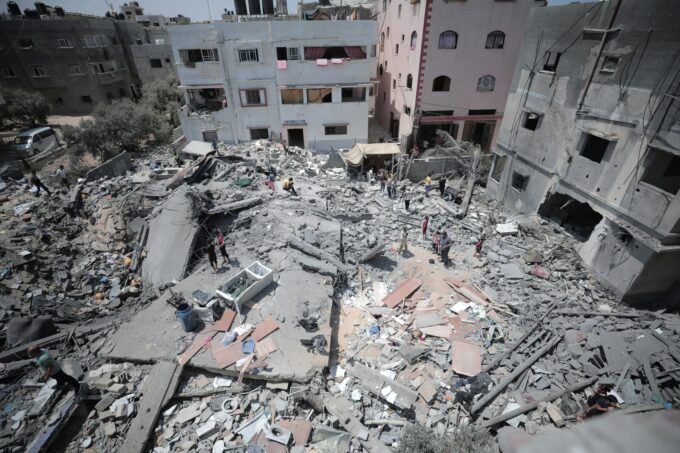
Image by Mohammed Ibrahim.
On March 23, 2025, Feroze Sidhwa—a surgeon working in Gaza—posted an urgent update on the social media platform X:
“I was at Nasser Hospital in #Gaza when it was bombed today. One of my patients, a 17-year-old boy, was killed. He would have gone home tomorrow. If I had been changing his dressings, as I planned to this evening, I probably would have been killed too. Attacking hospitals is a war crime, and it needs to stop.”
The attack described by doctor Sidhwa killed at least 2 people, and injured others. And, as Shurafa and Magdy report, “like other medical facilities around Gaza, Nasser Hospital has been damaged by Israeli raids and strikes throughout the war.” Indeed, consider a few more recent headlines and stories that illustrate this harsh reality for Palestine’s medical practitioners and patients.
On March 21, 2025, Gaza Notifications posted a video announcement on X, with the caption “
The day before this, a Daily Brief headline from Human Rights Watch read as follows: “Israel’s Deadly Cruelty in Gaza Hospitals.” That same morning, journalist Hossam Shabat shared news that “The Israeli occupation is no longer allowing doctors and nurses to enter Gaza.” Four days later, Hossam himself was killed by the Israeli military.
A few days prior to those headlines, a doctor in Gaza reported his situation at Baptist Hospital in Gaza City. He said “It was just mostly women and children burned head to toe, limbs missing, heads missing.” Medical workers in Gaza face exceptionally challenging circumstances while trying to do their job—to make people better.
As horrendous as these stories are, they are not new. For instance, recall the lead-in story that started this essay, which detailed an attack on Nasser Hospital in March 2025. Eleven months earlier, an April 2024 story by Doctors Without Borders reads “How the Israeli army besieged Nasser Hospital: Evidence points to deliberate and repeated attacks by Israeli forces on Nasser Hospital, once the largest hospital in southern Gaza.”
One could rewind the clock back even farther, to the earlier months of what is now Israel’s 17-months-long-and-counting genocide in Gaza, and find similar stories (yes, it’s an amply documented genocide…and Dr., Nimer Sultany keeps an accessible list of research/reports outlining this reality). It is estimated that around 400 healthcare workers were abducted by the Israeli military by March 2025. During this year-and-a-half period, similar instances kidnappings and torture of medical workers, the targeting of medical vehicles (e.g. ambulances), and a full-scale annihilation of nearly all medical facilities in Gaza were amply documented
We should refer to these types of all-out-attacks on healthcare as acts of medelacide. In Latin, medela means health/healing/cure, while ‘cide refers to the deliberate killing of. So, the intentional and systematic destruction of healthcare infrastructure should be considered an act of medelacide. It is the destruction of the capacity for people to be healed, or receive remedy for their ailments in the short or long term.
This term should be thought of in relation to several other well-known socio-legal concepts. As I outline (see pages 4-5) in my research on Israel’s decimation of Gaza’s healthcare infrastructure:
“Just as genocide refers to the intentional targeting of a people for systematic destruction (OHCHR, [1948] 2024), just as ecocide refers to the systematic and perhaps irreparable damage to a region’s ecology/ environment (Stop Ecocide Foundation, 2021), and just as scholasticide refers to the intentional and systematic destruction of a country or people’s institutions of learning (OHCHR, 2024), medelacide should now enter our vocabulary as a plausible framework for understanding the intentional and systematic destruction of a country or people’s healthcare and medical infrastructure.”
As healthcare workers in Gaza face nearly impossible circumstances to care for the tens of thousands of injured and dying, Drop Site News relayed information from Dr. Marwan Al-Hums, Director of Field Hospitals in Gaza. The March 20, 2025 report outlined:
➤ The majority of martyrs arriving at hospitals in Gaza suffer from severe burns and full-body amputations.
➤ Dismembered bodies and severe burns are the predominant injuries.
➤ Since March 18, the bombing has been unprecedented in intensity and weaponry.
➤ Israel is using new American weapons after replenishing stockpiles, causing complete cell disintegration.
➤ Many injuries involve “amputation without bleeding” due to burned limbs.
➤ Medical teams are trying to reconstruct limbs for future prosthetics despite limited resources.
➤ Gaza’s Health Ministry lacks labs to test chemical weapons but has evidence for international analysis.
➤ The only DNA lab was bombed by Israel, forcing families to identify loved ones through remains or clothing.
Just one week prior to this news, we saw the following headline from the United Nations Office of the High Commissioner for Human Rights: “‘More than a human can bear’: Israel’s systematic use of sexual, reproductive and other forms of gender-based violence since October 2023.” Included in this report were the following observations:
“The Commission found that Israeli authorities have destroyed in part the reproductive capacity of Palestinians in Gaza as a group through the systematic destruction of sexual and reproductive healthcare, amounting to two categories of genocidal acts in the Rome Statute and the Genocide Convention, including deliberately inflicting conditions of life calculated to bring about the physical destruction of Palestinians and imposing measures intended to prevent births”
The annihilation of hospitals. The annihilation of doctors. The annihilation of nurses. The annihilation of life-saving care. The annihilation of the chance to improve one’s lot in life. The annihilation of the ability to bring new life into this world. The annihilation of life. Medelacide…Genocide.

Photograph Source: Jaber Jehad Badwan – CC BY-SA 4.0
Summary: Ms. Kamla, a previously displaced UNRWA English teacher returns to her home in Central Gaza as tanks continue to fire until minutes before the ceasefire on January 19, 2025. She shares some of her experiences surviving the Gaza Holocaust and reflects on the future for her family in Gaza.
The following narrative is based on WhatsApp interviews conducted with Ms. Kamla at the beginning of August 2024 and on January 24, 2025 as well as a few sporadic text messages.
“What’s this?” asked four-year-old Joody. She hadn’t seen a banana in over a year. It was four days after the ceasefire and aid had begun to enter Gaza. She reached to eat it with the peel on. Her mother Kamla said, “It’s a banana.” and showed her how to peel and eat it. “Do you want to eat it?” Kamla asked. “Okay.” said Joody.
Such was the mixed blessing of the ceasefire. Some of the pressures of immediate survival were lifted, but this let you see in sharper relief how much you had lost.
***
On Sunday, 19 January 2025, Day 466 of the U.S. backed Israeli genocide in Gaza, Ms. Kamla a brave and resourceful 30 year-old English teacher, her math teacher husband Hazem, and their three young kids: four year-old daughter Joody, five year-old son Thaer, and eight year old daughter Balsam were together on the third floor of their partially destroyed house in al-Maghazi.
Four days before, for reasons that remain opaque but most certainly are entirely solipsistic, the cruel people that rule the United States finally yanked the chain, a chain they had held lightly and loosely for over a year while supplying billions in high-tech weapons, and forced the rabid Israelis into accepting a ceasefire. It was the same deal that had been offered for over a year, and the Palestinians, including Ms. Kamla and her family had suffered mightily and indescribably every single day while valiantly resisting the high tech genocide, even by simply continuing to live and care for each other in Gaza.
On this most auspicious day, this family was counting down the time until the ceasefire went into effect. A drone flew overhead making a buzzing sound… zzzzzzzzzzz…. You never knew when the sound of the drone meant something terrible would happen. There were so many mixed feelings. Ms. Kamla thought of all the lost relatives and people injured, lives cut short and futures altered in sometimes irrevocable ways.
Kamla and her family had been displaced many times. Early on, her parents and siblings evacuated al-Bureij because Israeli tanks invaded their neighborhood and came to stay with Kamla. Three days later, on 28 December 2023, two months after the start of the aggression, the Israelis attacked her neighborhood. They bombed the houses around her and an UNRWA school. Many people died. An Israeli tank fired a shell into her living room. Fortunately no one in her family was hurt, but the house was unlivable and so they moved to the camp in Dier al-Balah and built a simple tent out of a tarp with some wood and leather.
13 February 2024 was the worst night of Kamla’s life. They were still living in a tent. Balsam had been shot by a quadcopter in the leg and had needed emergency surgery at Al-Aqsa Martyr’s Hospital in Dier al-Balah where there were no beds left. The Israelis had not only deployed terror weapons but also restricted medical supplies and food from Gaza in a medieval siege. Kamla had done her best to comfort Balsam and found some expensive eggs to feed her after much searching through the markets. The exhausted but heroic doctors removed the bullet from her leg in a three hour surgery without anesthesia and little Balsam was able to walk again.
Kamla spent almost a year living in tents, using the bathroom at the local mosque, cooking exclusively canned food using firewood as there was no gas. There was almost never any water to wash the kids. When it rained, everything would get muddy. Time and time again, the family would have to evacuate the camps in al-Magazhi for a week at a time or more and come back because of the vicious Israeli attacks on refugees. In the winter, this was especially hard, because it was often rainy and cold. At one point, they lived briefly in a boiler room. Another time they lived with her sister who was living in between rubble as her house was destroyed months before.
They had all lost weight, and Hazem had lost 20 kilos (44 pounds). It wasn’t because they had been on a diet, but because of the forced starvation of Gaza—that and all the running they had to do. Kamla thought the world of Hazem. He had been strong like a mountain, never resting or complaining, giving energy to Kamla and the kids. A lot of the men in Gaza had been like that for those that needed them. Hazem had lost his brother in the war. His brother was martyred by a bombing in the street.
The Israelis did not always clearly announce that they wanted people to leave, and so heavy bombing would suddenly start and some bombs would hit tents or houses. Belatedly, that was how you would realize an evacuation was being “requested.” One time, an Israeli drone bombed a tent, leaving three martyrs, and set numerous tents ablaze. Fortunately, Kamla had evacuated to a nearby school and her family was not hurt.
By July 2024, the kids had not been to school in hundreds of days. Both Kamla and Hazem were too busy with the daily tasks of survival to do the teaching themselves. There was no electricity or gas. Everything needed to be washed by hand and the water had to be fetched manually when it was available. They cooked and baked exclusively canned food on a wood fire. Kamla in particular was caring for 4-year old Joody, who was always scared and had nightmares about the constant bombing.
There were some local educational initiatives in the camp, but they were worried the initiatives could become targets. The Israelis were infamous for bombing and invading schools. In September 2024, UNRWA would report that 85% of all schools had been hit or damaged and 70% of UNRWA schools had been hit, sometimes several times, some severely damaged or flattened. In July alone, 21 strikes on schools serving as shelters were recorded in Gaza, resulting in hundreds of deaths.
It was an impossible situation. Do you let the kids grow up illiterate and innumerate? The Israelis said from the start that this could be years. Eventually they decided to send the kids, since these informal initiatives might escape the Zionists’ notice. Kamla depended on Allah and prayed to protect them. Fortunately, these prayers were answered and no harm came to the children.
Thaer and Balsam sat in a group of 50 pupils in a single room with no chairs or desks. Yet, the room was painted with numerous beautiful murals with Palestinian themes to create a welcoming environment. All through each class, the sound of bombing was relentless. They learned Arabic, English, and Math and had some simple homework. Thaer, quiet and intelligent, loved math, and he eagerly learned it with Balsam even though he was her junior. Kamla exclaimed, “At least they learned something! We Gazans love to learn and are eager to educate our kids.”
These were the thoughts running through their minds as they sat on pins-and-needles waiting for the ceasefire. When she had first heard of it, Kamla had such mixed feelings about the ceasefire. She thought of her relatives, of all the people who had been injured. Would Israel even hold up their end of the deal? Would they pull out at the last moment? They were infamous for breaking promises.
Israel had been stepping up attacks as the ceasefire neared. Twenty-minutes before 8:30 AM, Israeli tanks shelled around Kamla’s house, sending a hot piece of ugly misshapen sharp metal shrapnel into her kitchen. Once again, luckily no one was standing there so they were unhurt, but the incident created a feeling of horror in everyone on the third floor and they decided to move to the first floor in case they needed to evacuate the building.
Their nerves raw, the clock finally struck 8:30am and most of the fighting stopped. Was it a sense of relief? Kamla knew that the Israelis could betray them at any time, that they will be back suddenly to bomb probably without notice. Despite the ceasefire, it was impossible to feel truly safe.
On the first day of the ceasefire, Kamla went to the beach. The eastern Mediterranean continued to be naturally beautiful even though all the evil inflicted on Gaza. A clear pale blue sky sat atop the deep blue-green hues of the sea. A few tents dotted the beach. The air inland tasted poisonous from the military bombing, burning, pulverized buildings, and also the cooking the refugees were forced to do on dirty wood or plastic burning fires. The seaside air was fresh, and finally for the first time in 466 days, Kamla could rest for a moment in a makeshift building as she gazed across the waters.
Kamla was a genocide survivor. A Holocaust Survivor. They all were. Anyone who experienced it, including the dead before their martyrdom, had their will forged into steel by simple circumstance. Kamla had become very strong and could depend on herself for anything. Great strength doesn’t mean one is numb though. Her thoughts raced with people and images of everything rushing through. Scenes of martyrs, horrific injuries, and the absolute black hole of voracious flattening destruction inflicted by the U.S. backed Israelis left their mark.
After the ceasefire, the Palestinians immediately began to dig in the rubble where they could not before. Body after body of martyrs were pulled out of the flattened and broken buildings. After the tanks left, they left bones lying in the street.
These scenes cannot be deleted from Kamla’s mind. Her heart is always bleeding, thinking of lost friends and relatives.
Kamla’s house in east al-Maghazi is close to the occupation’s border wall. While Israeli forces withdrew from most of Gaza, they remained at the wall. Anyone who wanted to go see their house after 470 days would risk being shot by tanks or quadcopters. Earlier on, Kamla and Hazem decided to take the risk to see what became of their house, to see what the Israelis had done to it, or if thieves had plundered it.
From time to time, zzzzzzzzzzz…. the Israeli drones would fly overhead collecting surveillance for targeting men, women, kids, houses, or tents. That buzzing noise is seared into mind of everyone that lived through the genocide.
On the other hand, finally, after 470 days, Snickers bars, biscuits, fruits, eggs, and chicken began to enter Gaza again. It wasn’t like before the war. Back then, the shops were full of all kinds of food. Still, it’s a positive step to have something fresh to eat even though the prices are still about three times higher than pre-war. At one point earlier on, the price of a kilogram of flour was 25 shekels (about $7 USD).
Now that the ceasefire was here all people could think of was to go home, not yet to the real return to where Palestinians had been displaced from outside the border wall, but to their homes in Gaza. To rebuild. To build upon the peace that will hopefully last for a while.
Kamla’s apartment needs a lot of work to live in properly. Her bedroom had the ceiling cave in on it early on after it was first attacked by a tank. The bathroom was destroyed as well. All the windows are broken by the overpressure waves from bombings. She and her family will need to figure out how to get enough money to mend all these things.
Thaer asked Kamla, “Can I go outside to play? Is it safe?” All the kids ask this daily. They are still living in the mood of the war. They don’t have toys and to be honest, it’s not particularly safe. They don’t have a safe place to play.
Someone in the U.S. Palestine Solidarity movement texted Kamla to ask what she felt about the ceasefire? What would the future hold?
Kamla wrote back.
“First we need to make sure the genocide is over, that it won’t be back, and then we can think about our future.
I always wished to travel and see what the world looks like, but I do not know where to go, or how to go, and how to pay for travel expenses. I’ve never been outside of Gaza, so the idea of leaving is very hard on me. I love Gaza, its streets, beach, buildings, and people.
We deserve to re-build Gaza again and stay in it peacefully.
We deserve to have the chance to work and make good salaries.
We deserve to live in peace in our own houses.
We deserve to have a rest from wars.
We love life and deserve to live.”
***
Kamla wrote. “Many thanks to every human being who continues to preserve their basic humanity and thinks of the Palestinian people. Many thanks to the people who have not become numb to the scene of our killing. For those whom want to help me and my family, I have my own GoFundMe campaign and will be thankful for those who donated to my family through it.”
Please donate to her in solidarity today: https://www.gofundme.com/f/humanity-beckons
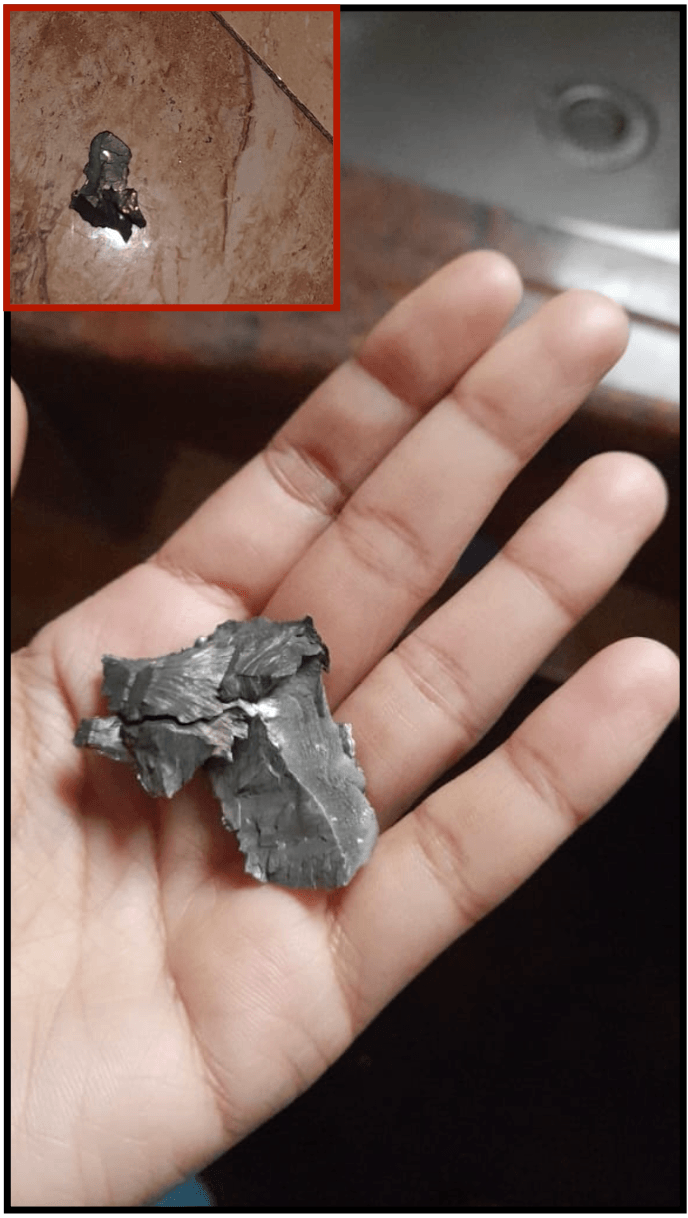
The piece of metal shrapnel resulting from Israeli tank fire early on 19 January 2025, the day of the ceasefire, that shot through Kamla’s kitchen. (red inset) The shrapnel was found on the kitchen floor.
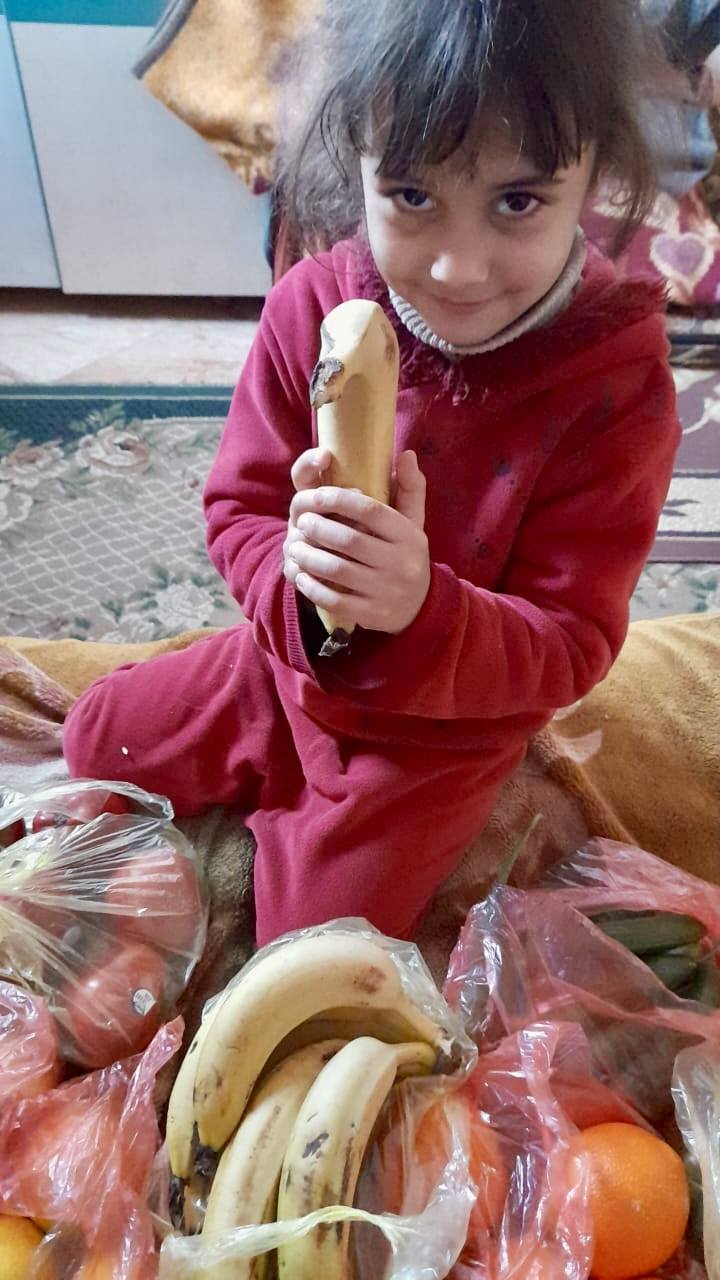
“What’s this?” 4-year old Joodie wonders what a banana is a few days after the ceasefire as some foods begin to enter Gaza again. Apples, bananas, oranges, and other produce are visible in the picture.

After the ceasefire, chocolates and eggs began to reappear in Gaza.

Thaer and Balsam attend the educational initiative sometime between November and December 2024. The teacher divided the students into two circles of 27 girls and 20 boys. They don’t have many supplies, but they are surrounded by beautiful Palestine themed artwork. You can see how much love their parents are investing in these kids. Despite so many living in tents during a genocide, they have presentable clothes and some even have cute backpacks, including Balsam (in purple). Thaer is visible (in olive green), but is mostly occluded.
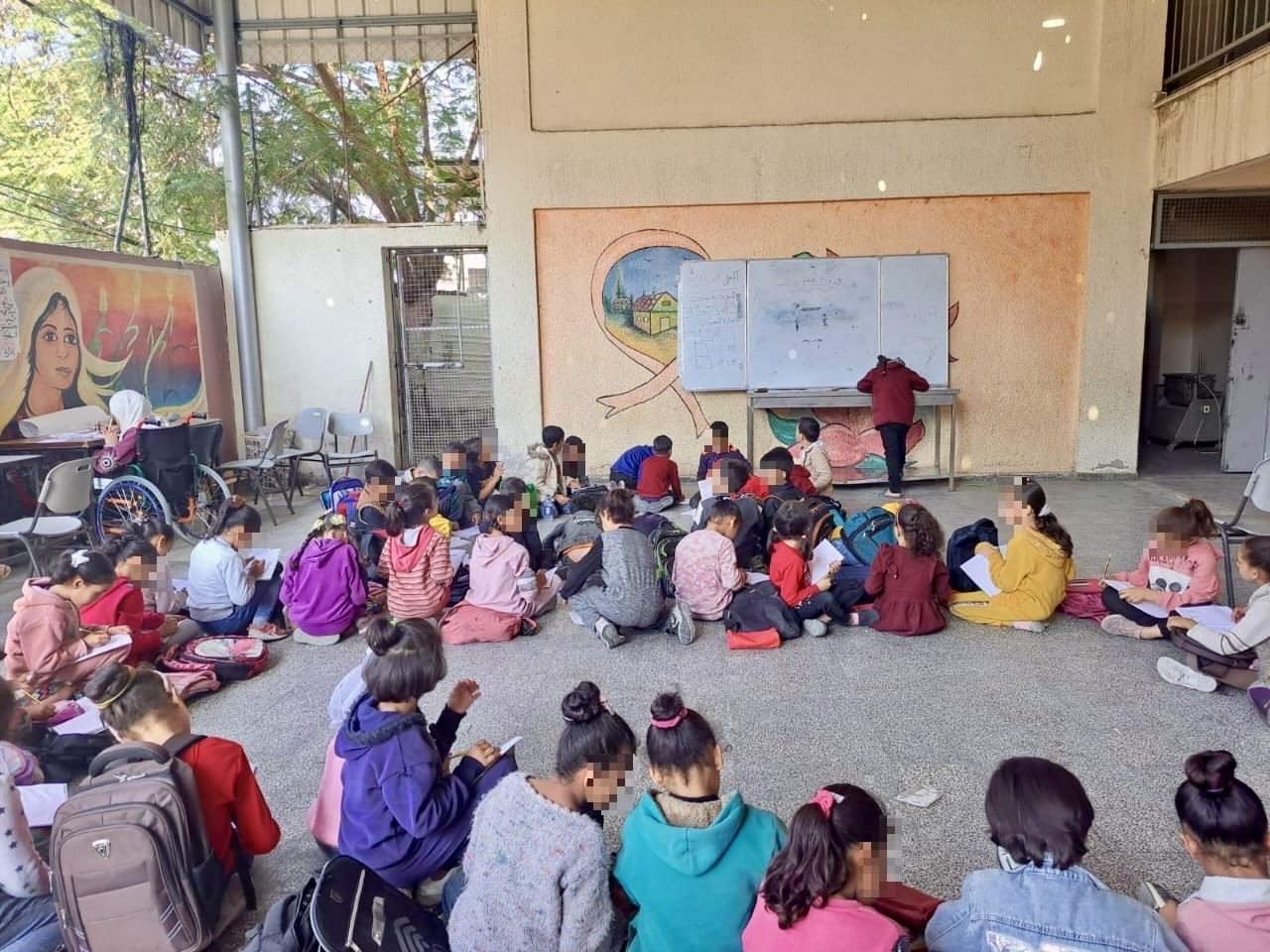
Students doing classwork at the educational initiative sometime between November
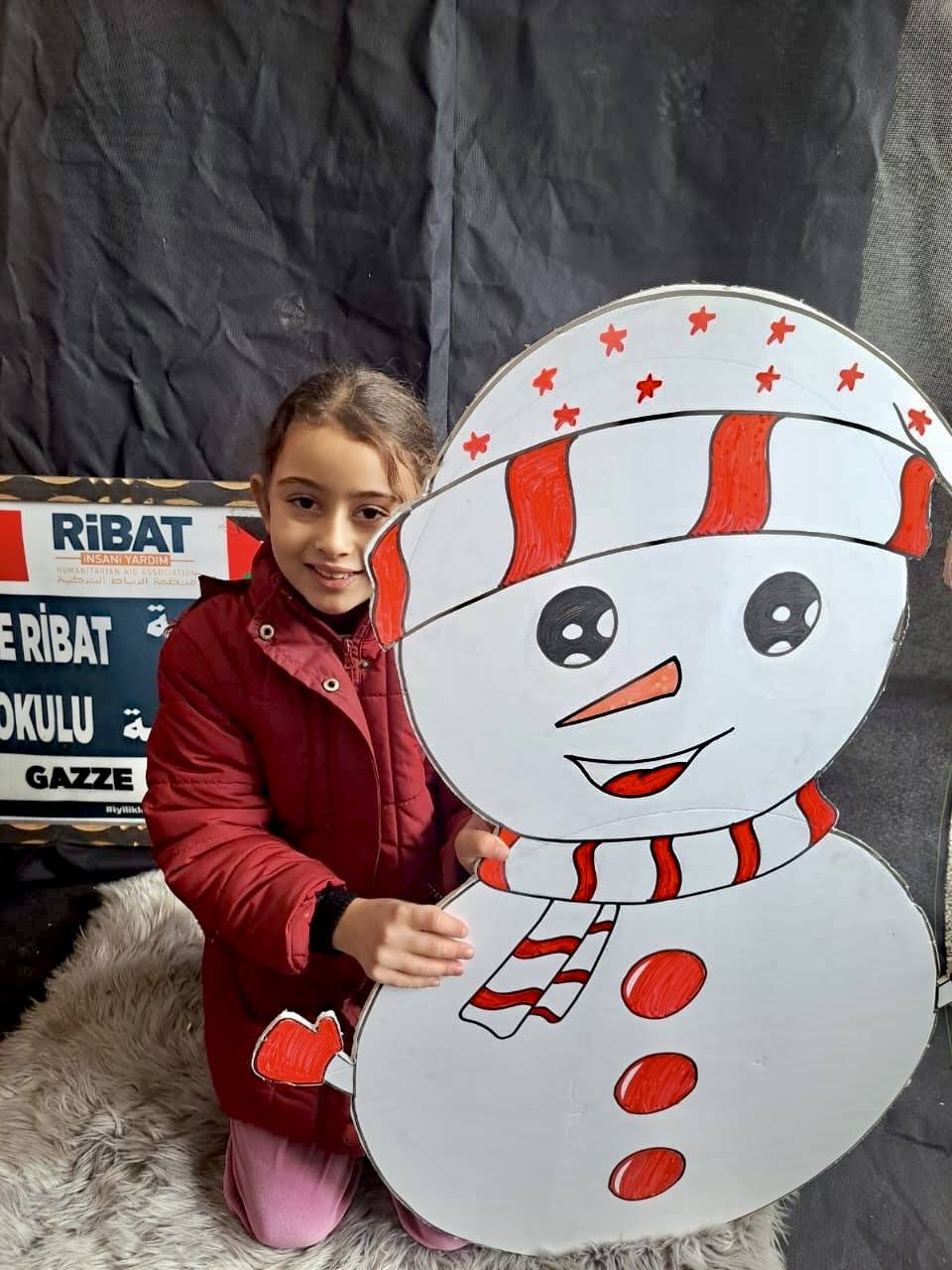
Balsam attends the educational initiative after recovering from her injury inflicted by the Israeli military.
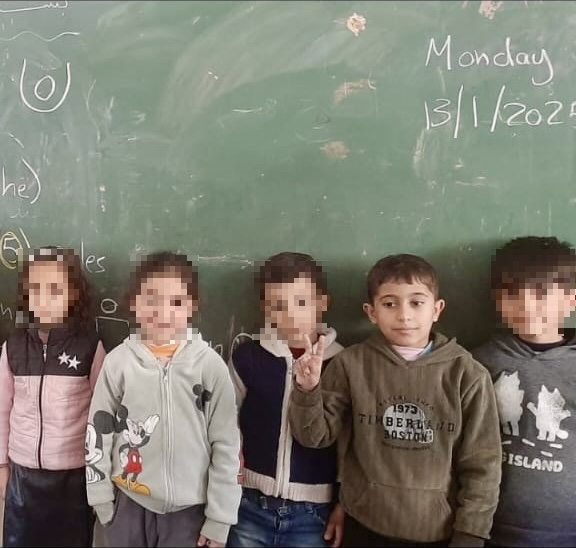
Thaer (second from right) attends the educational initiative on Monday, 13 January 2025.
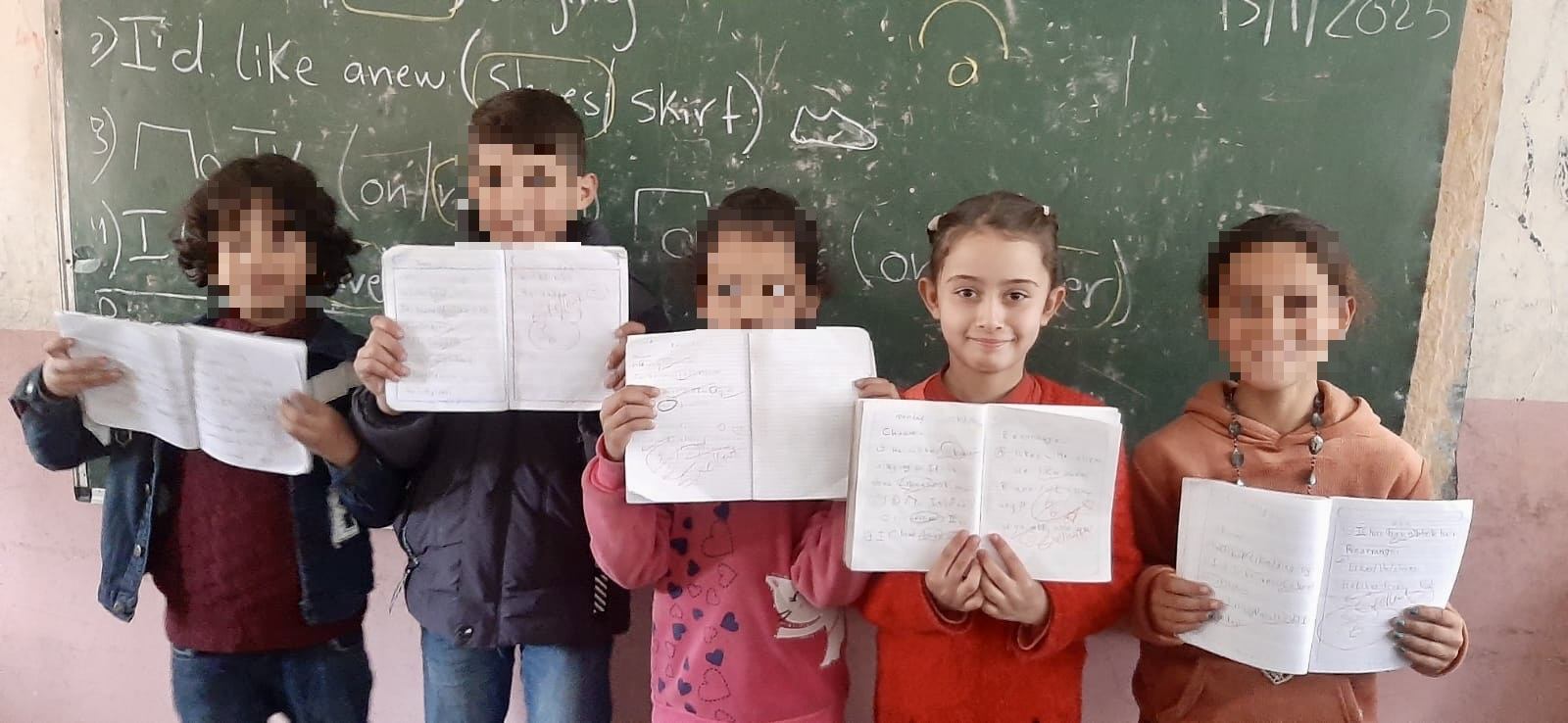
Balsam (second from right) attends the educational initiative on 13 January 2025. The students display some of their graded language work.
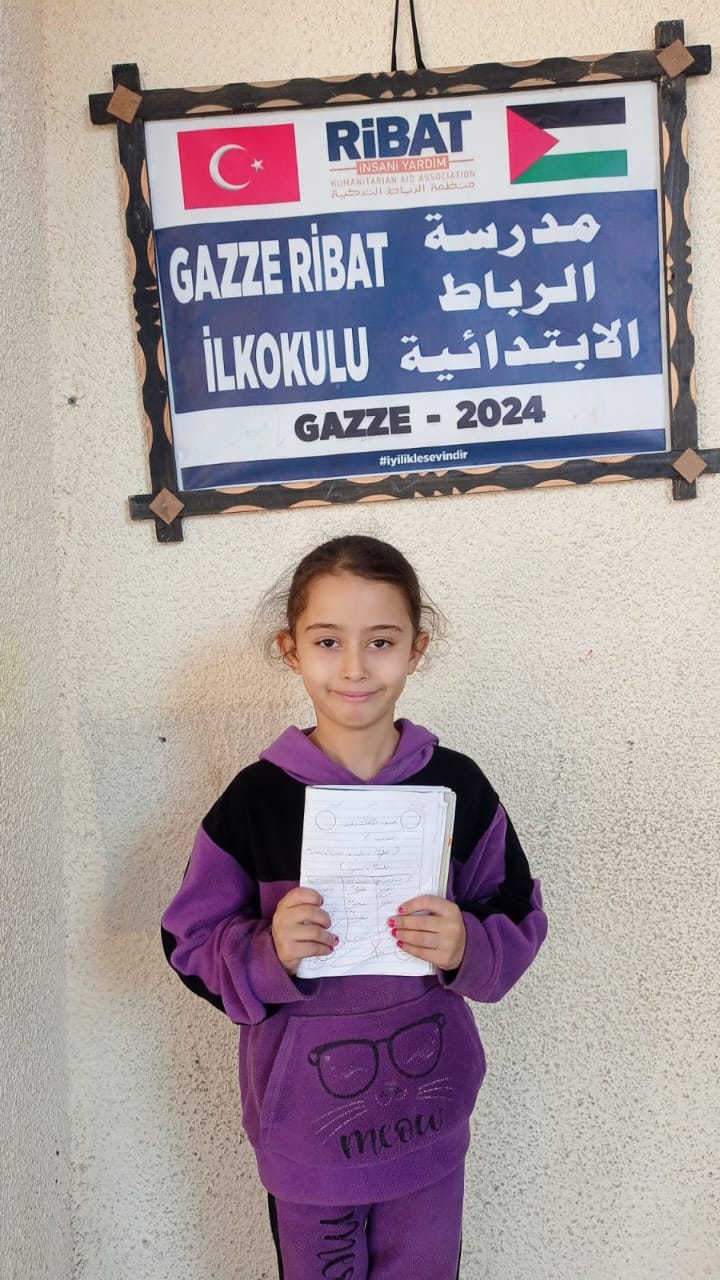
Balsam attends the educational initiative in 2024.
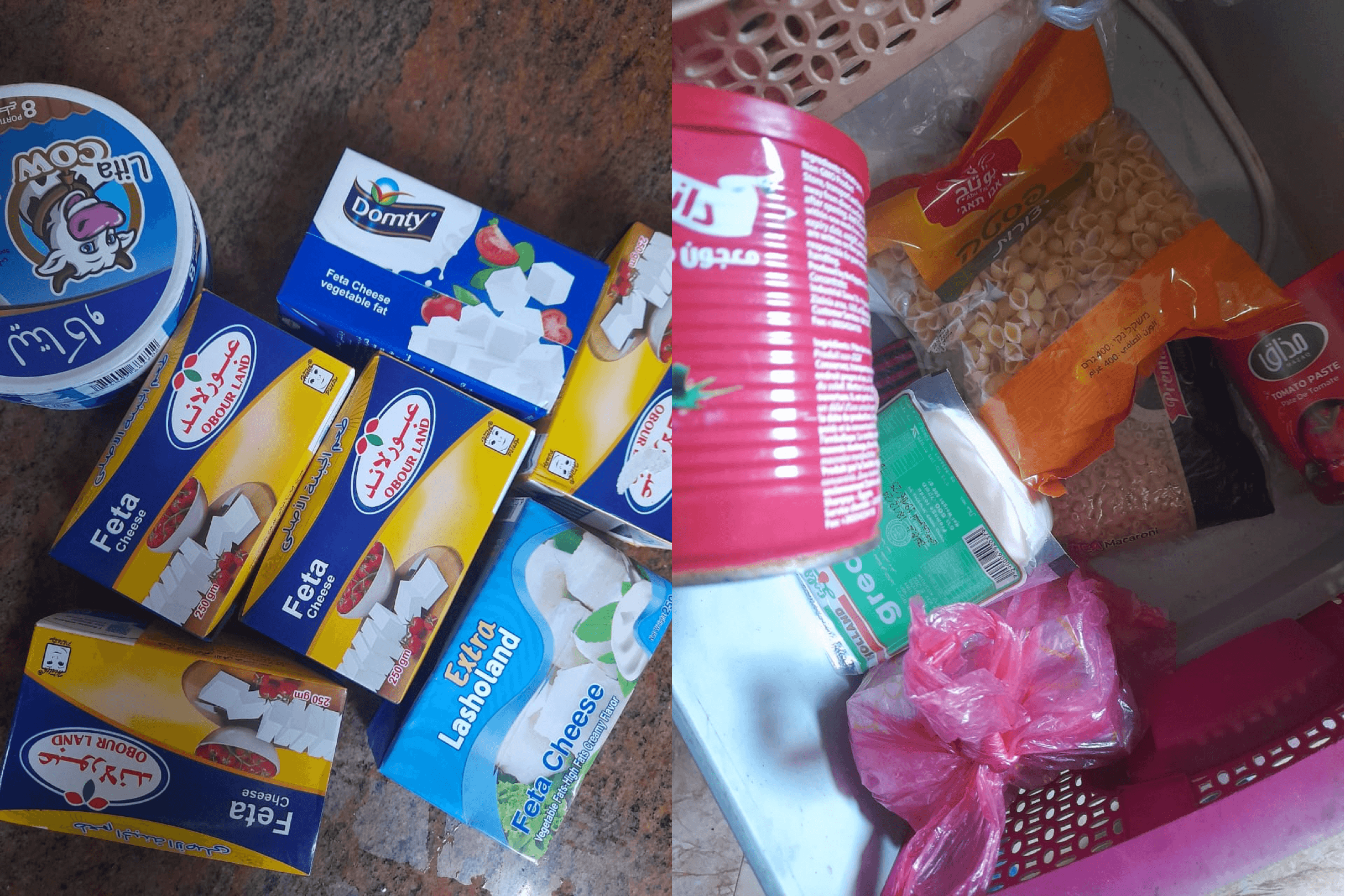
Kamla shared some examples of the kind of food they were subsisting on for over a year. (left) feta cheese (right) dry noodles, tomato sauce, and a few other items. Almost no fresh food was available during this period.
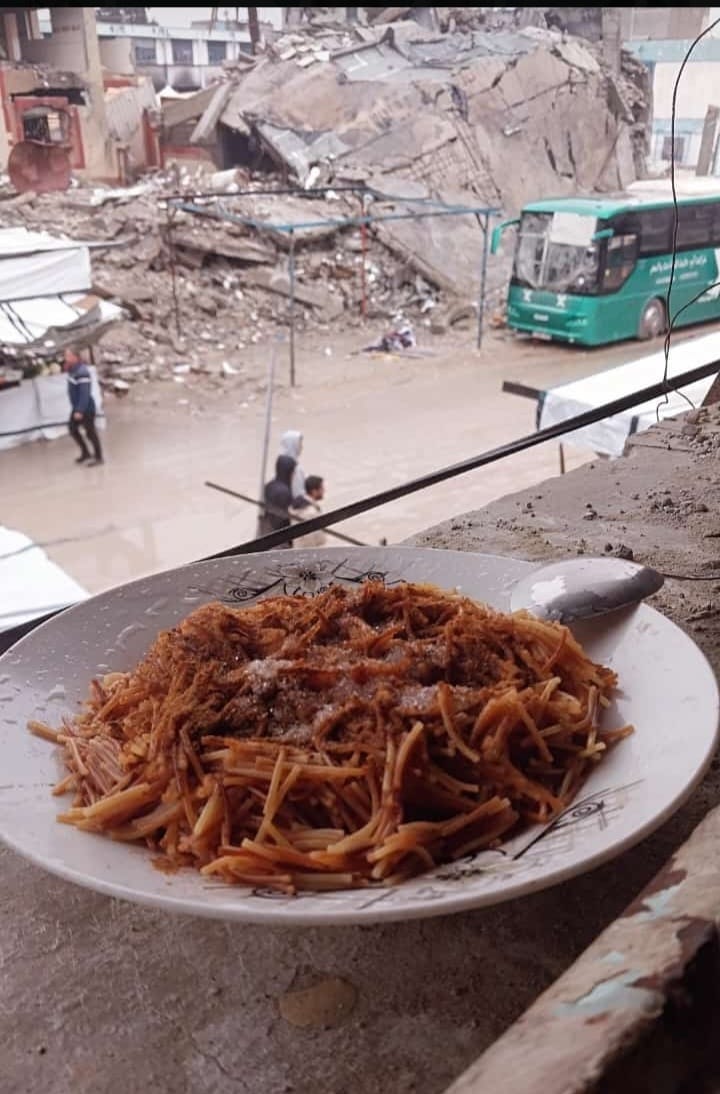
At one point Kamla stayed with her sister when she had to evacuate the camp due to Israeli bombing. She eats a plate of shearya, a dessert often made in cold weather, as she looks over at her sister’s house across the street—completely destroyed.
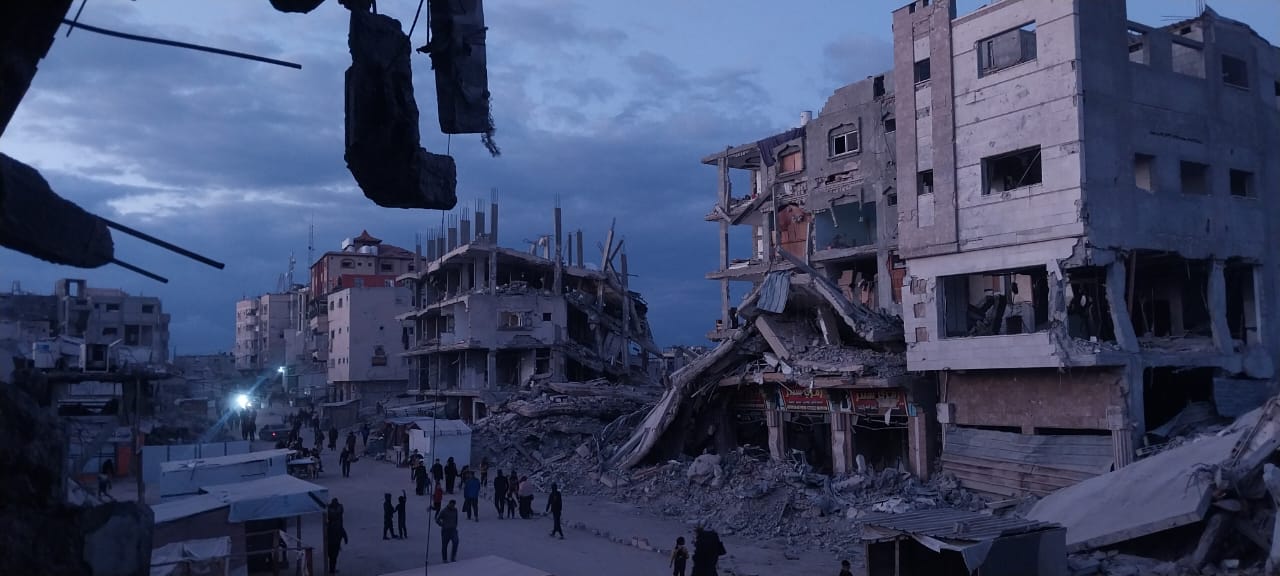
Kamla’s sister lived between rubble due to her house being completely destroyed. She stayed with her a while when the camps were too dangerous.
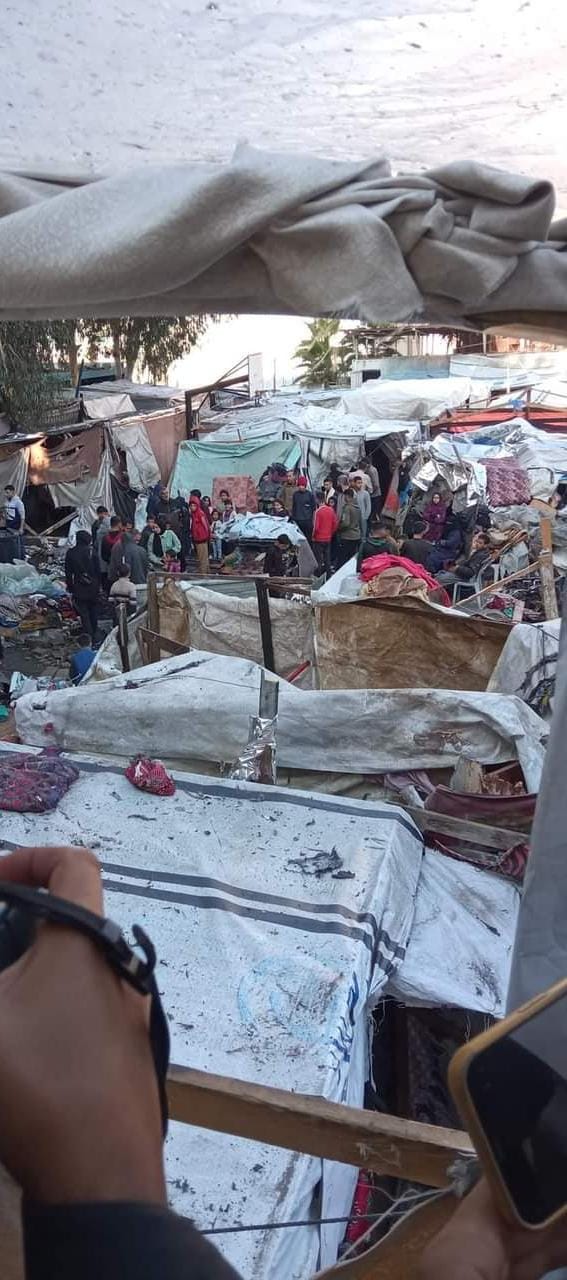
An Israeli drone bombed a tent (center of photo) in Kamla’s camp in al-Maghazi on 4 December 2024. The attack martyred three men, injured more, and damaged many tents. In this photo, people are gathering in shock right after the attack to see what happened. Kamla and her family evacuated to a school temporarily soon after.
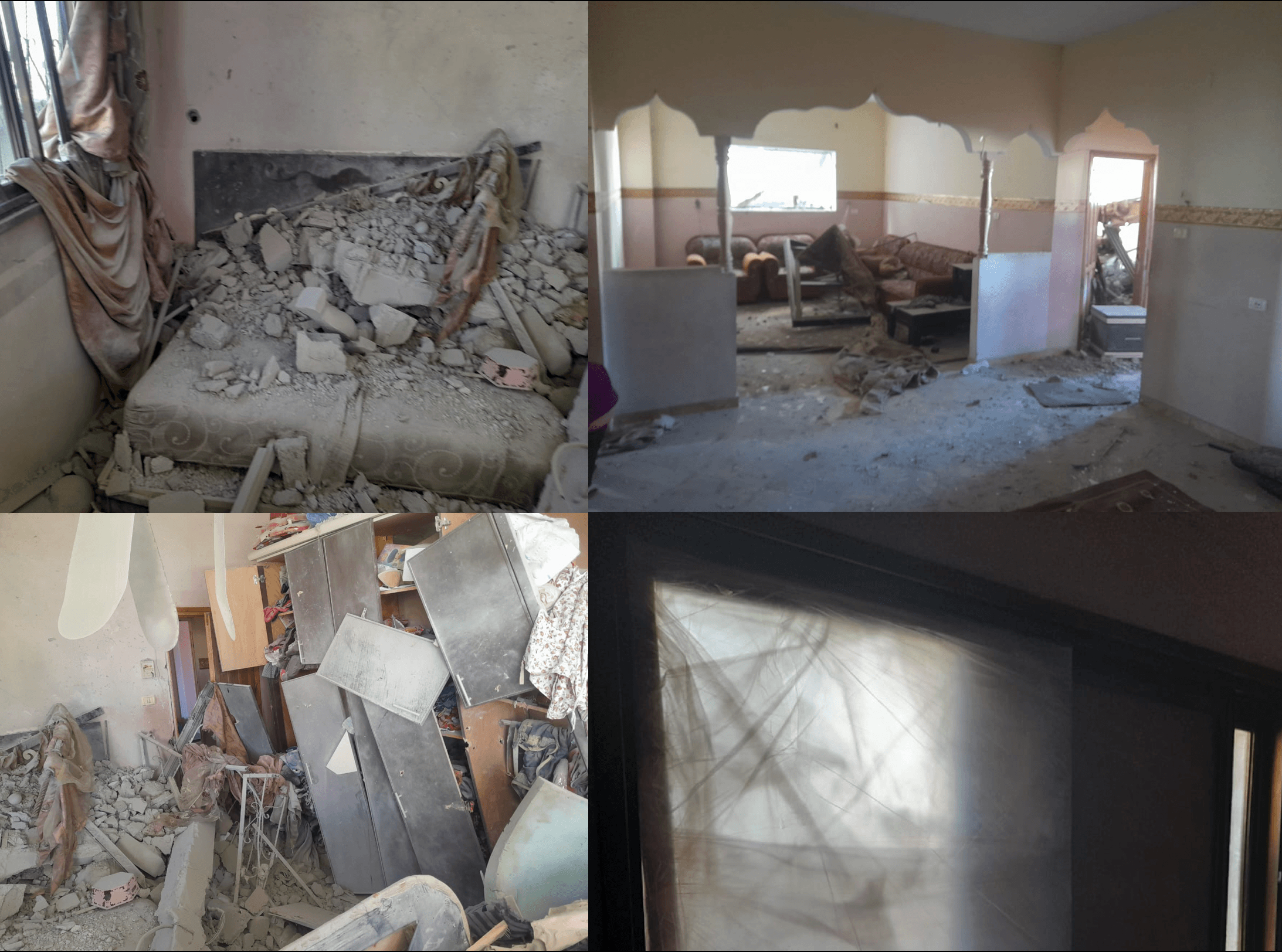
(top and bottom left) and bathroom (not shown). The living room (top right) is filled with debris and all the windows are broken. When Kamla and her family returned a few months ago, they covered up the broken windows with plastic (bottom right). The Israeli tank attack on Kamla’s eastern al-Maghazi home wrecked her bedroom.
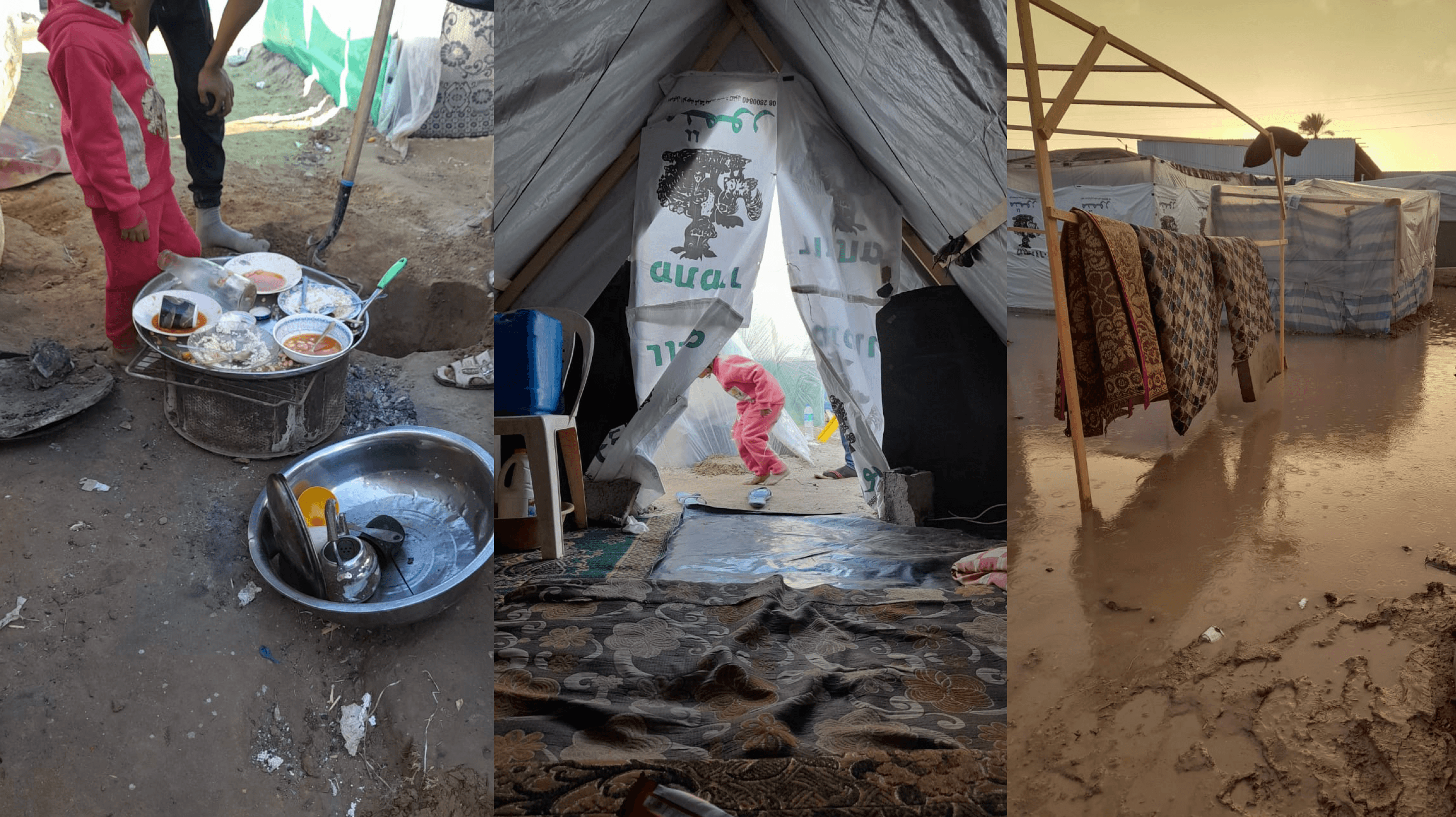
Scenes from camp life earlier in the genocide. (left) Joodie watches as the family cleans up after cooking a meal on a fire pit. (middle) Joodie plays outside their tent. (right) Drying bedding gets rained on.
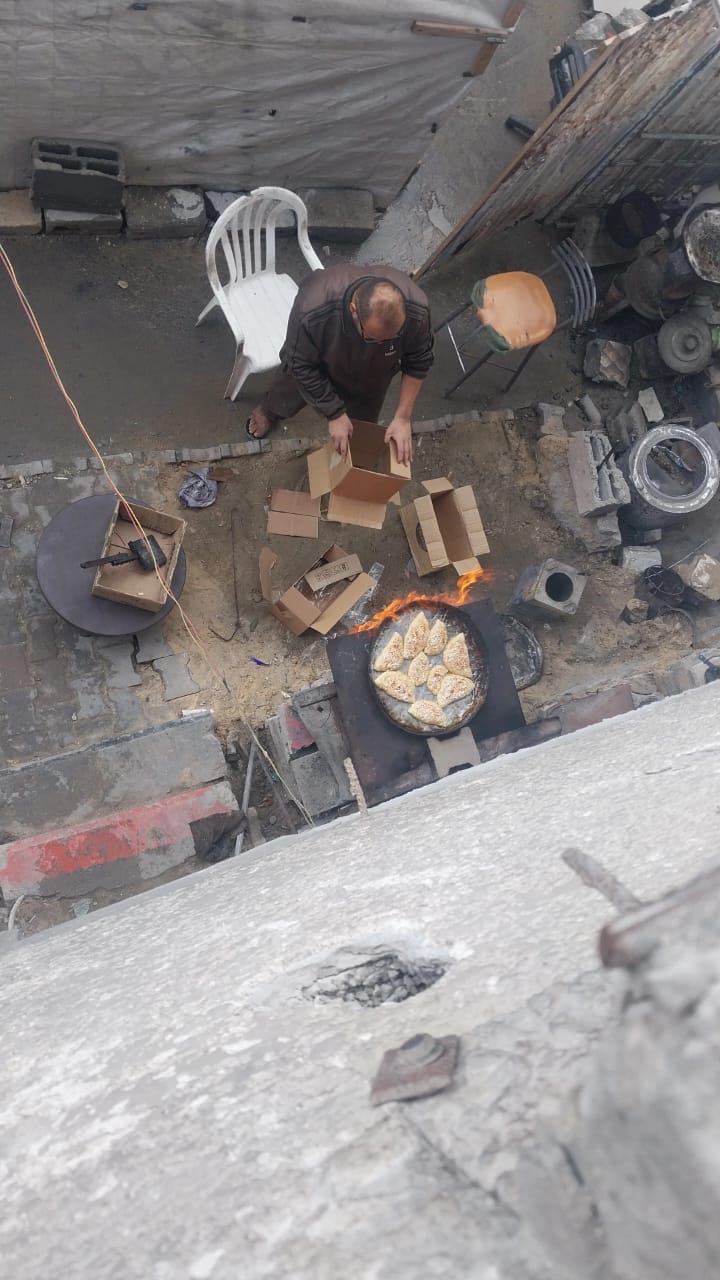
Kamla’s brother-in-law fries bread in oil on a fire.
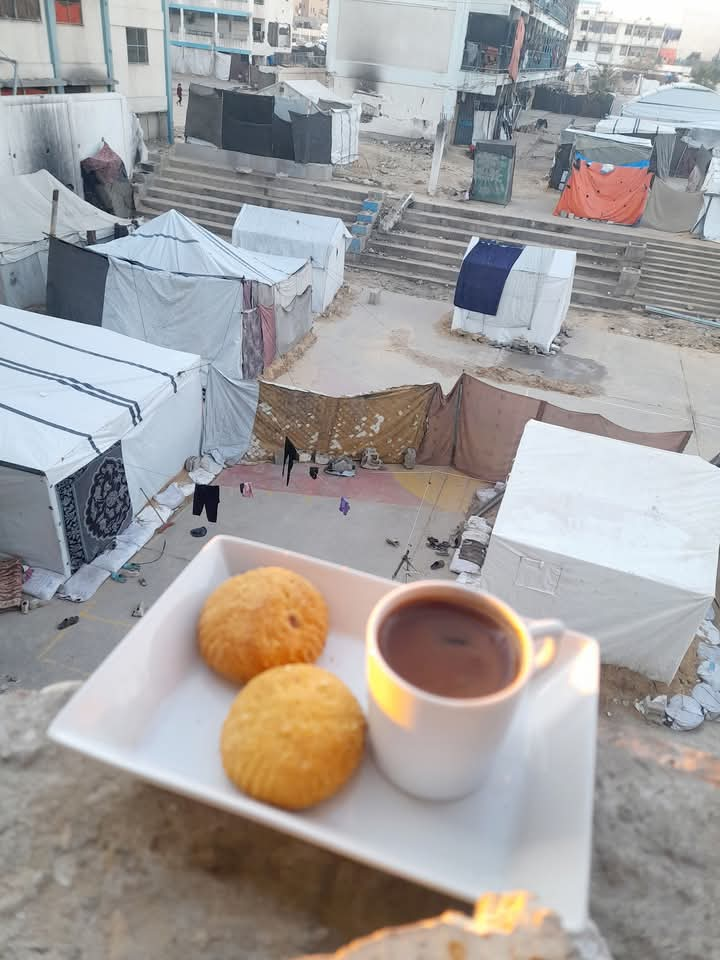
Another time the family had to evacuate the camp to a school.

On 19 January 2025, Kamla visits the beach to take a rest after the ceasefire goes into effect.
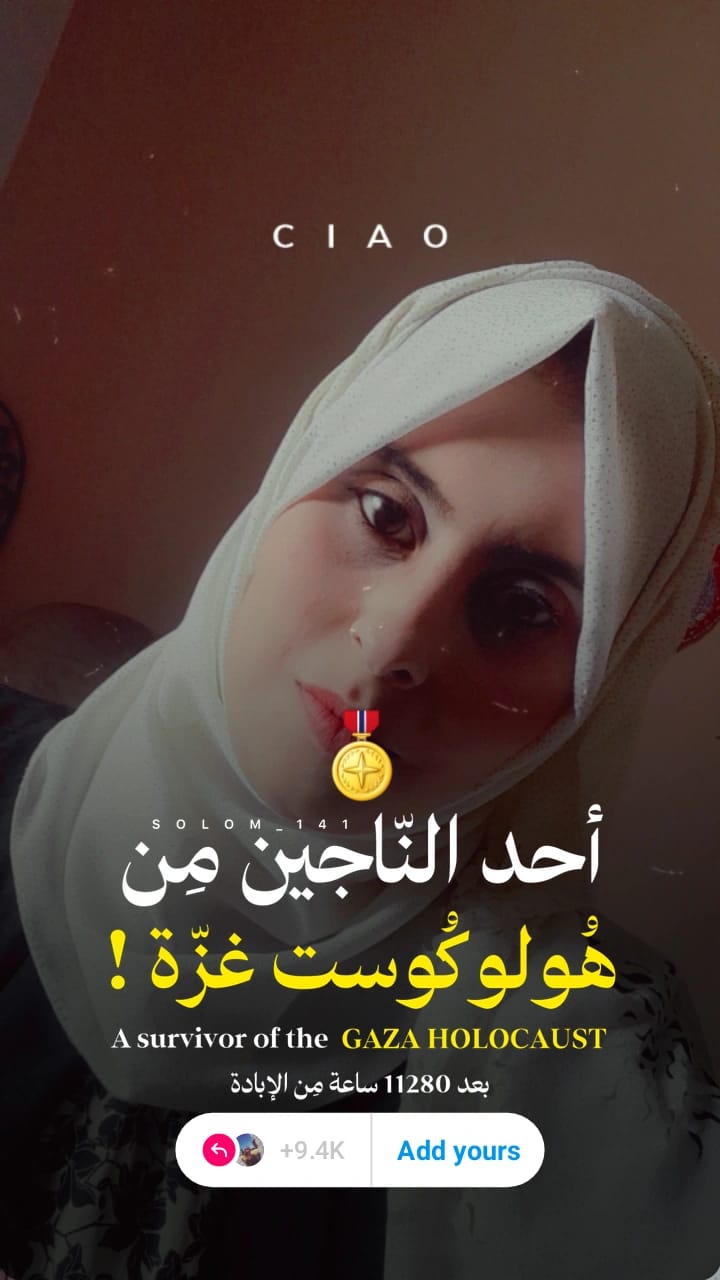
Kamla shares a meme of herself that was going around in Gaza on Ceasefire Day. “A survivor of the GAZA HOLOCAUST. 
No comments:
Post a Comment